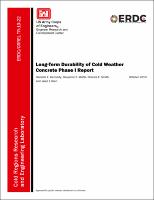Please use this identifier to cite or link to this item:
https://hdl.handle.net/11681/34464Full metadata record
| DC Field | Value | Language |
|---|---|---|
| dc.contributor.author | Kennedy, Danielle E. | - |
| dc.contributor.author | Watts, Benjamin E. | - |
| dc.contributor.author | Smith, Charles E. | - |
| dc.contributor.author | Oren, Jared I. | - |
| dc.date.accessioned | 2019-11-01T18:19:45Z | - |
| dc.date.available | 2019-11-01T18:19:45Z | - |
| dc.date.issued | 2019-10 | - |
| dc.identifier.govdoc | ERDC/CRREL TR-19-22 | - |
| dc.identifier.uri | https://hdl.handle.net/11681/34464 | - |
| dc.identifier.uri | http://dx.doi.org/10.21079/11681/34464 | - |
| dc.description | Technical Report | - |
| dc.description.abstract | The placement of conventional concrete in sub-freezing temperatures necessitates costly, labor-intensive measures to prevent freezing and ensure adequate early strength. An alternative method of sub-freezing concrete construction employs antifreeze admixtures which concurrently depress the freezing point and accelerate the hydration of fresh concrete. This concrete mixture has been applied successfully in cold regions where there are sub-freezing temperatures, ultimately enabling an extension of the construction season. In the last two decades, multiple field demonstrations of this technology have been implemented, many of which remain in service. The materials and mixtures used at these sites were evaluated in the short term with laboratory testing; however, most have not been inspected over time to evaluate their long-term durability in service. This document includes characteristics of durability, such as nondestructive and destructive testing measures to determine durability under long-term field conditions. | en_US |
| dc.description.sponsorship | United States. Army. Corps of Engineers. | en_US |
| dc.description.tableofcontents | Abstract ............................................................................................................................................................. ii Figures and Tables ............................................................................................................................................... v Preface ............................................................................................................................................................... vi Unit Conversion Factors .....................................................................................................................................vii Acronyms and Abbreviations ............................................................................................................................ viii 1 Introduction ................................................................................................................................................ 1 1.1 Background ....................................................................................................................... 1 1.2 Research needs .................................................................................................................. 1 1.3 Military needs .................................................................................................................... 2 1.4 Objectives .......................................................................................................................... 3 1.5 Approach ........................................................................................................................... 3 1.6 Scope ................................................................................................................................ 3 2 Literature Review ........................................................................................................................................ 4 2.1 Factors of durability ............................................................................................................ 4 2.2 Salt induced corrosion of reinforcing steel ............................................................................. 4 2.3 Freeze thaw durability ......................................................................................................... 4 2.4 Durability Testing ................................................................................................................ 6 2.4.1 Destructive testing .................................................................................................................... 6 2.4.2 Nondestructive testing ............................................................................................................... 7 2.5 Review of admixtures used in CWAS ...................................................................................... 8 2.5.1 Accelerating/antifreeze admixture chemistry ............................................................................... 8 3 Review of CWAS development and Implementation....................................................................................12 3.1 Laboratory screening and selection of CWAS ....................................................................... 12 3.1.1 Plastic properties .................................................................................................................... 14 3.1.2 Slump loss ............................................................................................................................. 14 3.1.3 Air content ............................................................................................................................. 15 3.1.4 Initial freeze point ................................................................................................................... 15 3.1.5 Compressive strength .............................................................................................................. 15 3.1.6 Freeze-thaw durability ............................................................................................................. 15 3.1.7 Time of set .............................................................................................................................. 16 3.2 Field implementation of CWAS ........................................................................................... 17 3.2.1 Sault Ste. Marie, Michigan ....................................................................................................... 17 3.2.2 Littleton, New Hampshire ......................................................................................................... 18 3.2.3 Rhinelander, Wisconsin ........................................................................................................... 19 3.2.4 North Woodstock, New Hampshire ............................................................................................ 20 3.2.5 West Lebanon, New Hampshire ................................................................................................ 21 3.2.6 Concord, New Hampshire ......................................................................................................... 22 3.2.7 Grand Forks Air Force Base, North Dakota .................................................................................. 23 3.2.8 Fort Wainwright, AK ................................................................................................................. 25 3.2.9 Fort Drum, New York ................................................................................................................ 26 3.2.10 Airfield damage repair ........................................................................................................... 27 4 Follow-on Field Site Investigations ............................................................................................................. 28 4.1 Equipment and test descriptions ........................................................................................ 28 4.1.1 Ultrasonic pulse velocity (UPV) .................................................................................................. 28 4.1.2 Ground penetrating radar (GPR) ................................................................................................ 28 4.1.3 Light weight deflectometer (LWD) ............................................................................................. 29 4.1.4 Coring .................................................................................................................................... 29 4.2 Field Site Investigations .................................................................................................... 29 4.2.1 Sault Ste. Marie, MI ................................................................................................................ 29 4.2.2 Fort Wainwright, AK ................................................................................................................. 33 4.2.3 Fairbanks, AK ......................................................................................................................... 36 4.2.4 West Lebanon, NH ................................................................................................................... 38 4.2.5 Treat Island, Maine ................................................................................................................. 42 4.3 Discussion of results ......................................................................................................... 43 4.3.1 Sault Ste. Marie, Michigan ....................................................................................................... 43 4.3.2 Fort Wainwright, Alaska ........................................................................................................... 43 4.3.3 Fairbanks, Alaska.................................................................................................................... 44 4.3.4 West Lebanon, New Hampshire ................................................................................................ 44 5 Conclusions and Recommendations.......................................................................................................... 45 5.1 Conclusions ..................................................................................................................... 45 5.2 Field specimen analysis ..................................................................................................... 45 5.3 Laboratory testing............................................................................................................. 47 5.4 Guidance and tools for implementation of CWAS ................................................................. 48 References ....................................................................................................................................................... 50 Report Documentation Page | - |
| dc.format.extent | 63 pages / 5.021 Mb | - |
| dc.format.medium | - | |
| dc.language.iso | en_US | en_US |
| dc.publisher | Cold Regions Research and Engineering Laboratory (U.S.) | en_US |
| dc.publisher | Engineer Research and Development Center (U.S.) | - |
| dc.relation.ispartofseries | Technical Report (Engineer Research and Development Center (U.S.)) ; no. ERDC/CRREL TR-19-22 | - |
| dc.rights | Approved for Public Release; Distribution is Unlimited | - |
| dc.source | This Digital Resource was created in Microsoft Word and Adobe Acrobat | - |
| dc.subject | Concrete--Service life | en_US |
| dc.subject | Concrete construction--Cold weather conditions | en_US |
| dc.subject | Concrete--Effect of temperature on | en_US |
| dc.subject | Concrete--Additives | en_US |
| dc.title | Long-term durability of cold weather concrete phase I report | en_US |
| dc.type | Report | en_US |
| Appears in Collections: | Technical Report | |
Files in This Item:
| File | Description | Size | Format | |
|---|---|---|---|---|
| ERDC-CRREL TR-19-22.pdf | 5.14 MB | Adobe PDF |  View/Open |